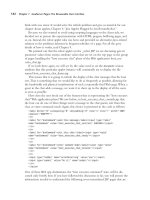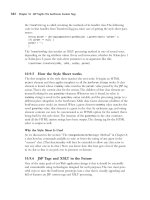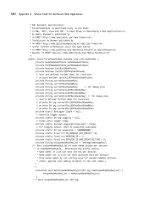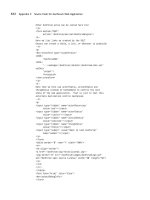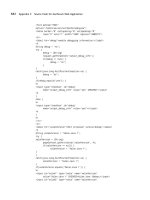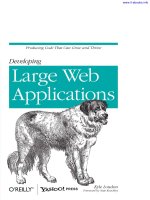Developing Large Web Applications- P3 pptx
Bạn đang xem bản rút gọn của tài liệu. Xem và tải ngay bản đầy đủ của tài liệu tại đây (239.04 KB, 10 trang )
CHAPTER 1
The Tenets
As applications on the Web become larger and larger, how can web developers manage
the complexity? In many ways, we need to turn to some of the same good practices
used in other types of software development. Generally speaking, these practices are
not yet pervasive in web development—that is, in software development primarily us-
ing HTML, CSS, JavaScript, and various server-side scripting languages (we’ll use PHP
for the server-side scripting in this book, but the same principles apply to many other
languages). Furthermore, the uniqueness of these technologies poses a challenge for
developers trying to apply good practices in a cohesive way.
One of the themes that you’ll see repeated in this book is the importance of extending
modular development practices to web development. This book presents concrete,
practical techniques to achieve modularity in large web applications. In the process,
we’ll explore many of the finer aspects of HTML, CSS, JavaScript, and PHP. You’ll find
that most of the techniques are relatively simple to apply, and none rely on the use of
specific frameworks. That said, it’s important to realize that they don’t preclude you
from using various frameworks, either; to the contrary, these techniques create a better
landscape in which to use many frameworks. As a case in point, we’ll look at several
examples that utilize the Yahoo! User Interface (YUI) JavaScript library.
At the outset, it’s important to establish why the techniques that we’re going to explore
in this book are especially useful for web developers working on large web applications.
We’ll begin by looking at some of the factors that contribute to the complexity of many
large web applications. Then we’ll explore how modularity plays an important role in
managing this complexity. Last, we’ll examine a list of tenets that will guide our dis-
cussions throughout the rest of the book.
Managing Complexity
If you consider how different the Internet is today from just 10 years ago, it’s clear how
complicated web applications have become and just how quickly the changes have
taken place. Far too often, this complexity makes large web applications difficult to
1
maintain, less reliable, and more costly over their lifetimes. Let’s examine some factors
that contribute to the complexity of many large web applications. Typically, large web
applications have the following characteristics:
Continuous availability
Most large web applications must be running 24/7. In addition, response times
have to be fast at any moment, even at peak load times. Web developers need to
write code that is especially robust.
Large user base
Large web applications usually have large numbers of users. This necessitates
management of a large number of simultaneous connections or layers of caching.
Web developers often need to write code to manage these situations.
Piece-by-piece delivery
Whereas many types of software are distributed as complete units, web applica-
tions have many parts delivered page by page, or connection by connection via
Ajax. As a result, large web applications operate within an environment effectively
shared by a huge number of users.
Diversity
It’s hard to think of a business or service that doesn’t have at least some sort of
web interface. For example, we see financial applications, ticketing sites, applica-
tions that organize massive amounts of data (e.g., search engines), media systems
(e.g., news sites), and the list goes on. Web developers need to write code that may
be reused in unexpected places.
Longevity
The largest web applications today, even those that have been around many years,
are just at the beginning of their lifetimes. Web developers need to write code under
the assumption that it will have to stand up to years of changes and maintenance.
Multiple environments
The Web is a fast-changing landscape littered with old browsers and other devices
that can be difficult to support. Users access large web applications from all types
of environments and with screens of wildly different sizes (including mobile
devices). Web developers must write code that can handle the numerous idiosyn-
crasies that result from this.
Real-time updates
Large web applications are not static; they are constantly fluctuating applications
for which changes are typically pushed to servers regularly. Web developers need
to write code to address this potential for moving parts.
Over time, web developers often end up addressing complexity in large web applica-
tions via one-off fixes and tweaks as their applications reach various breaking points.
But there is a better way. This book will show you how to address challenges like the
ones above head-on from the start. Mitigating the complexity from these challenges
can often be attributed to one or more byproducts of modularity that we’ll examine in
2 | Chapter 1: The Tenets
a moment. For example, I stated above that large web applications need to be available
all the time. From the perspective of the web developer, this is an issue of reliability,
which modularity plays a key role in addressing.
Modular Components
In a large web application, to address complexity with modular components, or
modules, you need to encapsulate everything the component needs within small, well-
defined pieces of the application. This allows you to divide a large application into more
manageable pieces that you can build with a specific focus and reuse wherever needed.
In addition, you hide (or abstract) the implementation details of each module and take
steps to ensure each module can operate more or less independently of the others. Even
relatively small web applications can benefit from such modularity. After all, the small
web applications of today are the Googles, Yahoo!s, and Amazons of tomorrow. Build-
ing web applications in a modular way at the start provides a solid foundation for future
growth.
Modularity seems like a simple thing, but it can be deceptively difficult to attain in a
cohesive manner across the HTML, CSS, JavaScript, and server-side scripts that web
developers write for large web applications. Let’s look more closely at the concept of
modularity and some basic ideas to help you achieve it.
Achieving Modularity
You achieve modularity in large web applications, as in other types of software, through
encapsulation, abstraction, and maintaining as much of a loose coupling as possible
among an application’s modules.
Encapsulation
Encapsulation is the process of bundling everything that a module requires within a
single, cohesive unit. Modules for web applications need to encapsulate all the HTML,
CSS, JavaScript, and PHP that they require. Chapter 7 shows how to accomplish this
using object-oriented PHP. We’ll also have to employ techniques in the HTML, CSS,
and JavaScript itself for a module to support this. These techniques are presented in
Chapters 3, 4, and 5, respectively.
Abstraction
Abstraction is the process of hiding details that should not be observable when working
with a module from outside its implementation. Defining a good interface is the key to
abstraction. Web applications present special challenges because HTML is not built
for hiding information in the manner that many languages enforce and because CSS
cuts across module boundaries, or cascades, and must therefore be managed rigorously.
Chapter 7 shows how object-oriented PHP can be used to define interfaces that abstract
Modular Components | 3
the details of working with sections of HTML and CSS. Data managers, presented in
Chapter 6, are good examples of interfaces that abstract working with dynamic data
managed by the backend.
Loose coupling
A loose coupling between modules means that one depends on the other as little as
possible and only in clearly defined ways. In Chapter 2, you’ll see that it’s relatively
easy to create a dependency graph that depicts the dependencies among objects in an
object-oriented system. When object orientation is used to implement modules in a
large web application, it’s easier to notice how changes to one part of a system may
affect another. The techniques presented for modular HTML and CSS in Chapters 3
and 4 also promote loose coupling.
Benefits of Modularity
Once you create modules that take advantage of encapsulation, abstraction, and loose
coupling, you’ll have better reusability, maintainability, and reliability across your en-
tire web application. When a module is reusable, it’s clear how to make it operate and
do new things. You can move it from place to place in the application with the confi-
dence that everything it needs to work properly will come with it, and that you won’t
experience unexpected consequences when you reuse the module. When a module is
maintainable, it’s clear which area of the application you need to change to affect certain
features and how to make the changes. Modules that are easy to maintain are more
reliable because they reduce the risk of side effects when changes take place.
Ten Tenets for Large Web Applications
With an eye toward modularity, we’ll use the list of tenets in this section to guide our
discussions in the chapters that follow. A tenet is a principle or belief that we will accept
as true—that is, it’s an assertion. A quick read-through of this list will provide you with
a high-level understanding of where we’ll be heading. Later, you may find this list to
be a concise reminder of the concepts we’ve discussed. Each tenet is examined in the
chapter with the corresponding number. For instance, Tenet 4 describes the robust use
of CSS, and Chapter 4 shows how to apply this tenet when implementing your CSS.
Tenet 1
Large web applications are built from modular components that are highly reusa-
ble, maintainable, and reliable.
Tenet 2
The use of object orientation in JavaScript and server-side scripting languages im-
proves reusability, maintainability, and reliability in large web applications by
promoting modularity.
4 | Chapter 1: The Tenets
Tenet 3
Large-scale HTML is semantic, devoid of presentation elements other than those
inherent in the information architecture, and pluggable into a wide variety of con-
texts in the form of easily identifiable sections.
Tenet 4
Large-scale CSS forms a layer of presentation that is separate from the information
architecture, applied in a modular fashion, and free of side effects as we reuse
modules in various contexts.
Tenet 5
Large-scale JavaScript forms a layer of behavior applied in a modular and object-
oriented fashion that prevents side effects as we reuse modules in various contexts.
Tenet 6
Dynamic data exchanged between the user interface and the backend is managed
through a clearly defined data interface. Pages define a single point for loading data
and a single point for saving it.
Tenet 7
Pages are constructed from highly reusable modules that encapsulate everything
required (e.g., HTML, CSS, JavaScript, and anything else) to make each module
an independently functioning and cohesive unit that can be used in a variety of
contexts across various pages.
Tenet 8
Large-scale Ajax is portable and modular, and it maintains a clear separation be-
tween data changes and updates to a presentation. Data exchange between the
browser and server is managed through a clearly defined interface.
Tenet 9
Large-scale HTML, JavaScript, CSS, and PHP provide a good foundation on which
to build large web applications that perform well. They also facilitate a good en-
vironment for capturing site metrics and testing.
Tenet 10
The organization of files on the server for a large web application reflects the ar-
chitecture of the application itself, including clearly demarcated scopes in which
each file will be used.
Ten Tenets for Large Web Applications | 5
CHAPTER 2
Object Orientation
Object orientation has been at the heart of many types of software for years, but web
developers using JavaScript and server-side scripting languages generally haven’t been
as fast to embrace it. In the early days, websites had fairly simple scripting needs, so
object orientation wasn’t crucial. Today, with the complexity of software on the Web,
an understanding of object orientation is fundamental to approaching the development
of large web applications with the same rigor as other types of software.
Throughout this book, we’ll explore many examples that use object orientation in PHP
and JavaScript, so it’s worth spending a little time to examine its importance and how
both languages address it. Both PHP and JavaScript have powerful support for object
orientation, but each implements it in different ways. One of the fundamental differ-
ences is that PHP is a class-based language. In class-based languages, you declare and
extend classes, which you then instantiate as objects wherever needed. This is object
orientation as C++ and Java developers know it. On the other hand, JavaScript is a
prototype-based (or object-based) language. In prototype-based languages, there are no
classes; you create objects on the fly and derive new ones using existing objects as
prototypes. Whatever the language, the following tenet (first described in Chapter 1)
articulates what we expect to achieve with an object-oriented implementation:
Tenet 2: The use of object orientation in JavaScript and server-side scripting languages
improves reusability, maintainability, and reliability in large web applications by pro-
moting modularity.
This chapter begins with an overview of object orientation and why it’s a good approach
in general. To this end, we’ll examine the fact that one of the most important reasons
for its popularity, often not easily articulated even by experienced developers, is that it
helps narrow the semantic gap between real-world problems and the solutions that you
build in software. Next, we’ll look at an example of how to visualize a web page in an
object-oriented way. Finally, we’ll explore some of the details behind object orientation
in PHP and JavaScript. We won’t cover all aspects of object orientation for each, but
we’ll explore the core features with an emphasis on those used in this book.
7
The Fundamentals of OOP
The fundamental idea behind object-oriented programming (OOP) is to group together
data (called data members in object-oriented parlance) with the operations that do
things with it (called methods). In PHP, you define which data members and methods
go together by placing them in a class, as shown in Example 2-1. In JavaScript, the
details are little different (as you’ll see later in the chapter), but the idea is the same.
Example 2-1. A simple class in PHP
class Account
{
protected $balance;
protected $minimum;
public function __construct($amount, $lowest)
{
// Initialize the data members when a new object is instantiated.
$this->balance = $amount;
$this->minimum = $lowest;
}
public function deposit($amount)
{
$this->balance += $amount;
}
public function withdraw($amount)
{
$this->balance -= $amount;
}
}
Note the use of $this in each method. It refers to the particular instance of the object
that’s currently being manipulated. This way, each account can have a different balance
and minimum, and when a deposit or withdrawal is made, it will always affect the
correct balance—the one for the account on which the deposit or withdrawal is
invoked.
Once you have the data members and methods bundled together, you create an instance
of the bundle as an object and invoke the methods to carry out various operations, as
shown in Example 2-2. In this example, each object is a separate instance of the class,
so after depositing $100.75 into $account1, that object has a balance of $600.75, while
$account2 still has a balance of $300.00. Of course, there is a lot more behind object
orientation than this, but this example illustrates some of the fundamental ideas.
8 | Chapter 2: Object Orientation
Example 2-2. Using an object in PHP
$account1 = new Account(500, 200);
$account2 = new Account(300, 200);
$account1->deposit(100.75);
Why Object Orientation?
To
understand why object orientation is a good approach to software development, it
helps to think about the following:
• What’s the natural way in which people tend to think about problems and, as a
result, build cognitive models to solve them?
• How can we draw visual models from our cognitive models in a standard way so
that we can work with them?
• How can software developers write code to resemble as closely as possible these
visual, and hence cognitive, models?
• How can we abstract problems in common ways to allow developers with diverse
backgrounds to collaborate?
In programs that are not object-oriented (programs written using traditional procedural
languages, for example), the models we create tend to be abstractions of the computer
itself: functions are abstractions of processors, data structures are abstractions of mem-
ory, etc. Since most real-world problems don’t look like a computer, this creates a
disconnect. Object-oriented systems more closely resemble our cognitive models and
the visual models drawn from them. As a result, object orientation fundamentally nar-
rows the semantic gap between the natural way we think about problems and how we
work with them on a computer.
To illustrate how object orientation narrows this gap, we’ll need a visual model that
we can translate into code. Let’s look at a standard approach for drawing visual models
from cognitive ones: the Unified Modeling Language (UML). Although UML defines
nine types of diagrams to describe components and their interactions or relationships
in systems, we’ll focus on just one: the class diagram.
UML Class Diagrams
If someone were to ask you to draw a model of how various components of a banking
system were related, you would most likely draw some combination of boxes or circles
for the components, and lines or arrows to show their relationships. UML class dia-
grams standardize this rather natural way to depict things. Stated formally, a UML class
diagram is a directed graph in which nodes (boxes) represent classes of objects and
UML Class Diagrams | 9
edges (lines or arrows) represent relationships between the classes. Two examples of
some of the relationships between classes are generalization and association.
Generalization
Generalization is the relationship between one class and a more general form of it. This
type of relationship is sometimes called an “is-a” relationship because one class is a
more specialized form of the general one. For example, a checking account is a more
specialized form of a bank account. In UML, you show generalization by drawing a
hollow arrow from a box labeled with the more specialized class to a box labeled with
the more general class, as shown in Figure 2-1.
Figure 2-1. Classes related by generalization
Association
Association is the relationship between one class and a class of something it contains.
This type of relationship is sometimes called a “has-a” relationship because one class
has a member within it. For example, a customer at a bank has an account. In UML,
you show an association by drawing an arrow from a box labeled with the containing
class to a box labeled with the class of its member, as shown in Figure 2-2 (you can
omit the arrowheads if both classes contain each other). You can also include a number
of instances next to the arrowhead or use an asterisk (*) to indicate any number of
instances, if you know these details.
Other items that you may include within the box itself are the operations the class may
perform and data members associated with the class that don’t aggregate any data
themselves (e.g., an account balance that is simply a number). Figure 2-2 shows ex-
amples of these items as well.
10 | Chapter 2: Object Orientation

